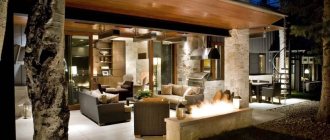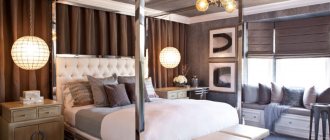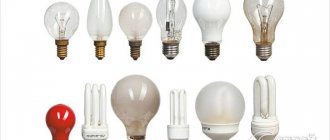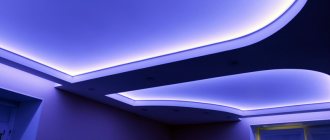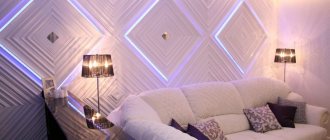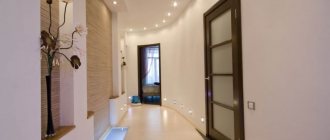Purposes of architectural lighting
The main goal is to attract attention and decorate it at night. An illuminated façade looks completely different, especially beautiful if the illumination was carried out by competent specialists who were able to emphasize and highlight the beautiful elements of the facade and hide flaws, if any. Also, by installing architectural lamps, it is possible to make the facades of simple box buildings more attractive, because With light you can draw any patterns by highlighting and cutting off “unnecessary” parts of the facade
The purpose of illuminating the facade of a country house is also safety, because... It is logical that hooligans are unlikely to dare to enter the illuminated courtyard.
For a shopping center or business center, the goal is to attract the attention of potential visitors and tenants
Types of architectural lighting
Modern lighting design includes several types of building lighting:
Flooding. It consists of many lamps for illuminating facades, which are located at a distance of 1.5 m from each other. As a result, the entire architectural structure is buried in warm colors.
Experienced designers use this technique in addition to the main light. Flood lighting is installed in the lower or upper part of the facade. It is the main highlight of architectural design.
Local. This type of lighting design is used to highlight individual elements of a building.
Hidden. It is divided into three types: silhouette, contour and color dynamics. The first type is used to give a soft silhouette to the entire house. It beautifully emphasizes the design of the architectural structure against the background of other buildings.
Contour adds elegance to individual lines. To do this, use LED strip or spotlights.
The third option is a combined backlight, which is used to create a moderate amount of light shadow. The photo of hidden facade lighting shows the ideal combination of the façade of the building with the adjacent landscape.
How to implement artistic lighting
It can be implemented in several ways:
- general light fill With its help you can illuminate a separate building among the total mass;
- local illumination The purpose is to highlight several architectural fragments. Please note: if there are repeating parts, their lighting will give special expressiveness;
- contour lighting It allows you to indicate the silhouette of a building using light. The building can be illuminated as a whole or in separate fragments. This way you can draw attention to columns, spiers and other elements;
- background illumination The goal is a special background of the building due to color. The backlight can be made movable and create an amazing play of light and shadows;
- various projections This refers to various images that are usually projected on the facade and can move;
- hidden lighting Designed for lighting stairs, lighting bridges, fountains;
- combined lighting Involves the use of several types of lighting at once;
- media façade is a type of façade illumination designed to change the color and intensity of the illumination. Controlled by a computer system.
Main types of contour lighting of facades
The architectural features of the structure dictate their requirements for the lighting design of the facade. Therefore, there are the following main types of contour lighting:
- Local. It consists of narrowly directed beams of light formed by wall spotlights of varying brightness. Allows you to emphasize the relief features of the exterior. This is the most economical and versatile option - suitable for any design and material.
- Flooding. Unlike the option discussed above, this type of contour lighting also uses spotlights, but with a wider beam of light. In addition, they are installed outside - on the ground or poles - and shine on the walls. As a rule, they are not installed for residential buildings due to the glare effect of windows.
- Along the perimeter. Ice strips, neon tubes, led-neon and other linear light sources are used as lamps. With their help, the perimeter and individual elements of the structure are identified.
- Background. The building stands out due to the luminous background located behind it. This allows you to outline the contours of a structure, for example, an ancient castle or palace. The base is LED tubes.
- Light facades. Performed only on buildings with a fully glazed façade. The lighting is installed indoors and shines outside. A variety of lamps are used.
- Dynamic. The system allows you to set a contour lighting program with changes in brightness, color, time and speed of transition between lighting effects.
What lamps are used for facade lighting
Street light
Designed to illuminate park paths, streets, highways, as well as individual buildings. It is widely popular for façade lighting. In some cases, lanterns can act as an independent decorative element.
Architectural lamp
A specialized lamp that has different parameters for the angle of the light beam, different shades of color temperatures to achieve the desired lighting effect
LED Spotlight
Designed for lighting industrial buildings and entrances. In artistic lighting it is used for general and local lighting, as well as creating certain effects.
Attached to a cable or guy wire. Traditionally used in lighting roads, parks and garden alleys, as an element of festive lighting. In addition, with the help of hanging lanterns, you can divide the facade of the building into certain geometric shapes.
Wall lantern
It is used to illuminate doors, corners of buildings, etc. Thanks to wall lanterns, you can create light spots on facades and columns, as well as highlight various architectural elements.
Sconce
Often used in lighting the facades of cottages. Ideal for creating local lighting.
Ground lantern
Most often used in garden design, as well as in lighting the foundation and basement. Easily integrated into asphalt, soil, paving stones, etc.
Wall swivel light
Indispensable when creating moving images on the facade.
LED Strip Light
It is used when it is necessary to make contour lighting and create a certain pattern on the facade. Since the tape is flexible, it is very convenient for realizing any design fantasies.
Garland
Columns, balconies, windows and some elements on the facade are decorated with garlands. Very often found in shopping center lighting.
Architectural lighting of a shopping center
Luminaire with optical system
Used when you need to create computer graphics.
What lamps are used in architectural and artistic lighting of buildings? They must meet certain requirements: have a long service life, not distort color, be resistant to temperature changes and water, energy-saving, safe for humans, and also unpretentious to use. Obviously, LED lamps meet all these requirements to the greatest extent.
Of course, incandescent lamps are often used in artistic lighting of facades. They have many disadvantages, for example, they are designed for a short time, but the soft yellow light and convenient form do not allow one to abandon them altogether. As an alternative, fluorescent lamps can be used. True, they are somewhat outdated and therefore are not used in visible places, for example, under the very roof of a building.
Statics and dynamics. DMX technology
Despite the fact that architectural lighting is used only at night, and in Russia the daylight hours in winter are short, today static lighting of buildings is not economically viable. To save energy on weekdays, less resource-intensive light sources should be used, and on holidays and weekends, on the contrary, a bright non-standard glow allows you to distinguish a building from others and attract attention with the play of colors. To do this, they use DMX technology, which allows you to control the light dynamics.
The essence of technology
DMX was originally the standard for lighting in the cinema and exhibition industries. Today this technology is also used in architecture. It allows you to control different groups of lamps, brightness and color of light. Separate groups can be, for example, the roof, facade, columns, window openings, contour lighting, etc. Within each group there are subgroups - by brightness, color, etc.
At the same time, for everyday life, the glow of one group is enough (you can set the optimal intensity), and on holidays, weekends, festivals, significant sports or other events, you can turn on all groups, increase the intensity of their glow, and also create various color shifts - a smooth or sharp transition one color to another, mixing colors and other effects. Grouping reduces the resource intensity of an individual lamp that has one signal; it is assigned one address - as a result, the overall cost is reduced.
Special equipment is used to control the dynamics of light.
More details in our video:
Stages of implementation of artistic facade lighting
First you need to make a design project. It is needed in order to be able to determine the power, number and installation locations of lamps, because without design it is not clear where on the façade we have “over-lit” and where we have “under-lit”. A lighting design project is not just a colorful drawing; first, a specialist makes lighting calculations in the program, and then creates a picture.
After the design project is ready, it is necessary to understand where the power cables will be laid and brought out to the façade to the installation sites of the lamps, what cross-section they will be and what brand they will be - for this, a technical project is developed, which also specifies the method of fastening the lamps, current loads are calculated, and a diagram lighting board, etc.
When the lighting design project and technical project are ready, lighting equipment can be purchased and installed according to their specifications. After installation and connection of the luminaires, commissioning work is carried out to achieve the best resemblance to the visualization in the design
Errors in façade lighting
The most important mistake is that façade lighting is carried out without a design project and often turns out completely different from what was imagined. Without design and calculations, it is very easy to “overexpose” the façade or, on the contrary, install lamps with too little luminous flux and the beam will not shine through the column, pilaster, or the distance of the façade is simply needed.
The next mistake is using metal halide lamps instead of LED lamps, in addition to the fact that LED lamps are economical and durable (although they are much more expensive, but it’s worth it) - they also have a very high color rendering index, so the white color of LED and halogen lamps will be significantly differ in favor of the former. LED lamps do not require the same frequent maintenance as halogen lamps
Another mistake is the incorrect choice of color scheme for façade lighting, because... It is impossible to illuminate a historical building with columns and stucco with bright colors such as pink, red, blue, green, but exclusively with white shades - cold, warm or a competent combination of them.
Lighting devices of various modifications for façade illumination
To make a house play, as they say, it is not enough to install a couple of standard outdoor lamps. Therefore, we approached the choice of lighting devices thoughtfully and with a certain amount of creativity.
The following were used in the project:
- single- and double-sided directional luminaires. The first illuminate the lower part of the facade, the rays of the second work in two directions - up and down;
- RGB diffused light fixtures with remote controls. They produce a soft and cozy light, not intensely directed, but diffused, similar to a colored haze with a smooth change of shades in the “red-green-blue” range;
- ordinary diffused light lamps. Their task is to complement and enhance the overall visual effect of façade architectural lighting;
- LED strips with warm and diffused glow. Such devices are widely used today in designer lighting of facades - they are affordable, thanks to the aluminum profile they are resistant to moisture, do not heat up during operation, and the ability to cut the tape into pieces of the required length allows you to create original compositions on facades and specifically focus attention on certain zones

